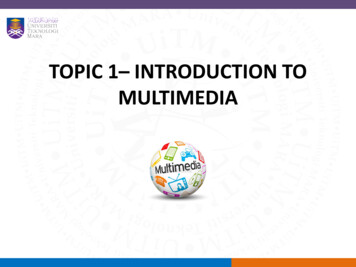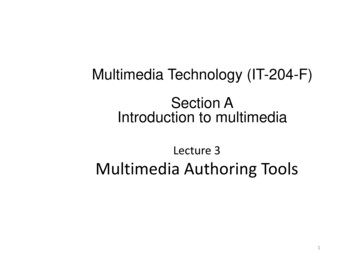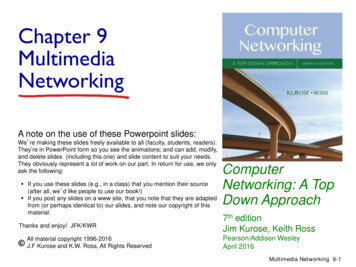
Transcription
TOPIC 1– INTRODUCTION TOMULTIMEDIA
Overview Introduction to multimedia.– Definition– Types of multimedia– Delivering multimedia Why multimedia? Applications of multimedia.– Examples of multimedia application SummaryCSC2532
Objectives At the end of this chapter, students should beable to:– define basic terms and concepts related tomultimedia technologies– distinguish between the types of linear and nonlinear multimedia systems– identify various applications of multimediaCSC2533
Introduction to Multimedia The definition of Multimedia :“Multimedia is any combination of text, art, sound,animation, and video delivered to you by computeror other electronic or digitally manipulated means. Amultimedia project development requires creative,technical, organizational, and business skills.”Tay Vaughan.Multimedia : Making it work 8th EdCSC2534
Multimedia is a combination ofCSC2535
Retention rate Studies indicate that if you’re stimulated withaudio, you will have about a 20 percentretention rate. With audio-visual, retention isup to 30 percent and in interactivemultimedia presentations, where you arereally involved, the retention rate is as high as60 percent.CSC2536
Multimedia Terminologies Interactive Multimedia: when a user is giventhe option of controlling the elements. Hypermedia: when a user is provided astructure of linked elements for navigation. Multimedia Developer : The people thatdevelop multimedia projects.CSC2537
Multimedia Terminologies The software vehicle, the messages, and thecontent together constitute a multimediaproject. A multimedia project shipped to end-userswith or without instructions is called amultimedia title. A project can also be launched on the Web.CSC2538
Introduction to Multimedia Types of Multimedia projects :1. Linear Multimedia: Projects that are notinteractive. Users have very little control overthe presentation2. Nonlinear (interactive) Multimedia : Projectsthat are user-interactive, where users are givennavigational control.CSC2539
Introduction to Multimedia1-Linear Multimedia– users can sit back and watch it just as they do amovie or the television– The presentation normally plays from the start toend or even loops continually to present theinformation.– A movie is a common type of linear multimedia.– Demo show, non interactive lectureCSC25310
Introduction to Multimedia2- Non linear (interactive) multimedia– When users are given navigational control and canwander through the content at will– Advantage: complex domain of information can bepresented.– Disadvantage: users might lost in the massive“information highway”.– Useful for: information archive (encyclopedia),education, training and entertainment.CSC25311
Non linear (interactive) multimedia Non linear means– Interactive– Users have control over the contents– Users are given navigation control– Example– Games , course ware , interactive CDCSC25312
Introduction to Multimedia Multimedia Projects can also be deliveredonline (webs) and through PDAs/Hand-heldDevices. The primary media for delivering multimedia projectsare:– Compact disc read-only (CD-ROM)– Digital Versatile Disc (DVD) / Blu-ray disc (BDA)CSC25313
CD-ROM– The most cost-effective distribution medium formultimedia projects.– It can contain up to 80 minutes of full-screenvideo or sound.– capacity 700MBCSC25314
DVD-ROM / Blu-ray disc– Multilayered DVD technology increases the capacity ofcurrent optical technology to 18 GB.– DVD authoring and integration software is used tocreate interactive front-end menus for films andgames.– Blu-ray disc (Blu-ray Disc Association BDA) is nextgeneration format for high-definition video and highdensity data. A single-layer disc can fit 23.3, 25, or 27GB (enough for approximately four hours of highdefinition video with audio). It supports 25GB for onelayer, 50GB for two and 100GB for fourCSC25315
ComparisonCapacityCDDVDBLU-RAY700MBUp to 8.5 GBUp to 120GBCSC25316
CD and DVD burners Software Both CD and DVD burners are used for readingdiscs and converting the discs to audio, video,and data formats.CSC25317
Why Multimedia? Ease of useIntuitive InterfaceImmersive experienceSelf-paced interaction and better retentionBetter understandingCost effectivenessMore funCSC25318
Applications of Multimedia Home– Most multimedia projects reach the homes viatelevision sets or monitors with built-in userinputs.– Movies on demand, games, instructional videoson gardening etc.CSC25319
Applications of Multimedia Public places– Multimedia will becomeavailable at stand-aloneterminals or kiosksto provide informationand help.CSC25320
Applications of Multimedia Business– Business applications include presentationstraining, marketing, advertising, product demos,databases, catalogues, instant messaging, andnetworked communication.CSC25321
Schools– Educational software can be developed to enrichthe learning process– move away from the transmission or passivelearner model of learning to the experientiallearning or active-learner model.CSC25322
CSC25323
Examples of Multimedia Application Digital video editingand productionsystems E-Newspapers/Magazines Games Groupware Home shopping Interactive TV Multimediacourseware Video conferencing Video-on-Demand(VoD) Virtual realityCSC25324
Virtual Reality Virtual reality is anextension of multimedia. It uses the basicmultimedia elements ofimagery, sound, andanimation. It requires terrificcomputing horsepowerto be realistic.CSC25325
(cont.) Virtual Reality In VR, cyberspace is made up of thousands ofgeometric objects plotted in threedimensional space. The standards for transmitting VR in VirtualReality Modeling Language (VRML) documentshave been developed on the World WideWeb.Emirates A380CSC25326
Examples: Flight simulators Surgery simulators Computer-controlled simulators teach theintricate loading and unloading of oil tankersand container ships (maritime academy).CSC25327
Acrophobia - extremefear ofheightsTrain your phobias away with realistic simulationsCSC25328
Summary Multimedia is a combination of text, graphic art,sound, animation, and video. There are two types of multimedia projects :linear or nonlinear. Multimedia projects are often stored on CD-ROMor DVDs. They can also be hosted on the Web. Multimedia is widely used in business, schools,public places, and at home. Virtual reality is an extension of multimediaCSC25329
The definition of Multimedia : "Multimedia is any combination of text, art, sound, animation, and video delivered to you by computer or other electronic or digitally manipulated means. A multimedia project development requires creative, technical, organizational, and business skills." Tay Vaughan th Multimedia : Making it work 8 Ed.










